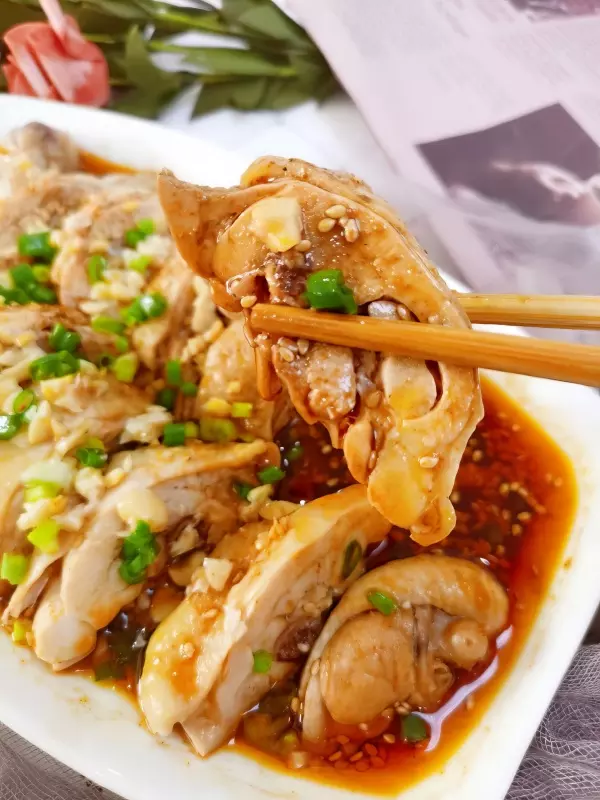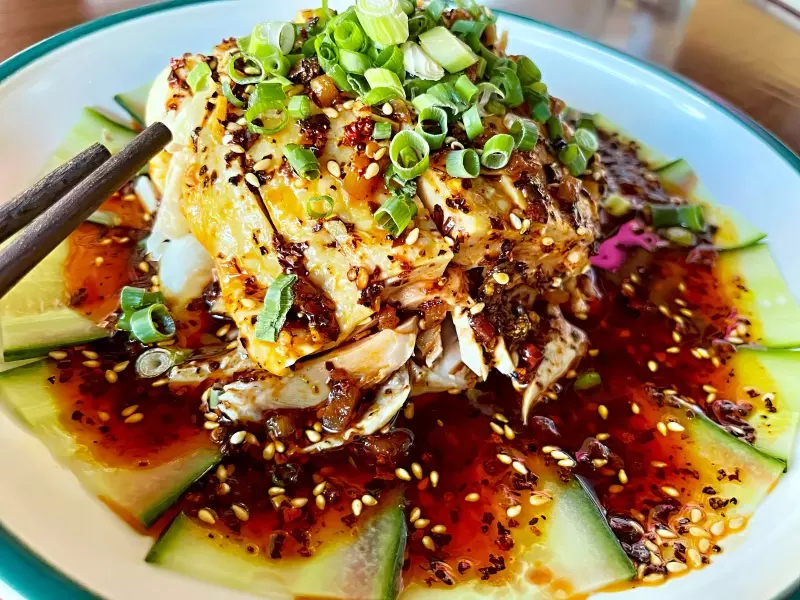Saliva Chicken: An Iconic Sichuan Dish
Saliva Chicken, or “Kou Shui Ji,” is one of Sichuan cuisine’s most iconic dishes, known for its richly spiced chili oil that perfectly enhances tender chicken meat. The name – 口 (mouth), 水 (water), 鸡 (chicken) – hints at an experience that quite literally makes your mouth water. Often translated as “Chicken that Makes Your Mouth Water,” this exotic name perfectly evokes the irresistible craving the dish inspires.
Contents:


In English, “Saliva Chicken” is the established translation, and while it may sound unusual, it aptly describes the effect of this dish. In Chinese restaurants in the Czech Republic, it might appear under names like “Sichuan Chicken in Red Oil Sauce,” though none fully captures the dish’s famed, unique flavor profile.
The History of the Name
The name “Kou Shui Ji” has its roots in a poetic reference to culinary pleasure made by the Chinese literary figure Guo Moruo. Previously, Sichuan locals simply referred to the dish as “spicy chicken” or “pepper chicken.” However, in the 20th century, Guo Moruo reminisced in his poem “Ji Bo Qu 賟波曲” about chicken he had eaten in his hometown of Shawan, writing, “White pieces of chicken and hot, fiery chili… even now, my mouth waters.” His words captured the unique flavor profile so vividly that the name “Kou Shui Ji” quickly gained popularity and spread.
Saliva Chicken in Sichuan Cuisine and Its Symbolism
Today, Saliva Chicken is beloved not only in Sichuan but in Chinese restaurants worldwide. It’s commonly served at Chinese celebrations and family gatherings as an appetizer or part of a larger meal, where its spiciness and complex flavor enhance the dining atmosphere. This dish symbolizes hospitality, joy, and the pleasure of sharing good food – qualities central to Sichuan cuisine. Though Saliva Chicken is typically served cold, its bold spiciness and nuanced flavor leave a warm impression on the palate.

Preparation and the Secrets to Its Flavor
Preparing Saliva Chicken involves boiling chicken, which is then quickly chilled in ice water. This step halts further cooking and firms the skin, adding authentic texture to the dish. The chicken is then dressed with a flavorful chili oil sauce, which is the heart of the recipe. Chili oil, along with Sichuan peppercorn (which leaves a pleasant tingling sensation on the tongue), gives the dish its characteristic “má là” 麻辣 flavor – a combination of numbing spice and pungency.
Roasted and crushed peanuts and sesame seeds add a crunchy texture and help balance the heat. In the traditional version, a whole chicken with skin and bones is cut into pieces, lending a rich flavor and texture. For easier enjoyment, you can also use chicken thighs, which are naturally juicy and absorb the sauce well.
Saliva Chicken offers a perfect taste of Sichuan, and its spicy, aromatic flavors make it an exciting addition to any meal.
Saliva Chicken (Kou Shui Ji 口水鸡)
Ingredients
Cooking chicken
- 500 g chicken thighs
- 2 tablespoons of ShaoXing rice wine
- 4 slices of ginger
- 2 pc spring onions
Sauce
- 4-6 tablespoons chili oil
- 2 tablespoons Chinese sweet soy sauce
- 1 tbsp soy sauce
- 1 tbsp Chinkiang vinegar
- 3 cloves of garlic chopped
- 1 teaspoon ginger chopped
- 1 pc Chopped cilantro for garnish optional
- 2 tsp unsalted peanuts
Instructions
- In a large pot, add the chicken, green onions and 3-4 slices of ginger and cooking wine. Then pour in enough water to cover the chicken. Bring the contents to the boil over a medium flame, turn down the flame and simmer the meat for 10 minutes.
- Turn off the flame and leave the chicken in the pot (covered) for another 10 minutes.
- While the chicken is cooking, prepare an ice bath by adding ice and water to a large bowl.
- Toast the peanuts in a cold wok over low heat until lightly browned. Let cool and then crush them into small pieces.
- Mix all the ingredients for the sauce together in a small bowl.
- When the chicken is cooked, transfer it to an ice bath using tongs. Set aside until the chicken has cooled completely. Transfer the chicken to a cutting board. Remove the bones and then cut the chicken into pieces and arrange in a bowl.
- Pour the sauce over the chicken and garnish with coriander and crushed peanuts
- Serve with rice


